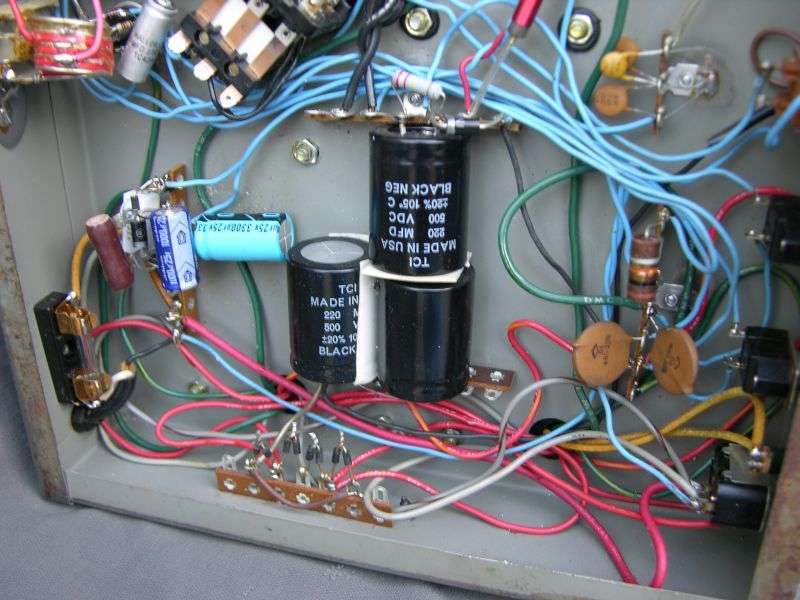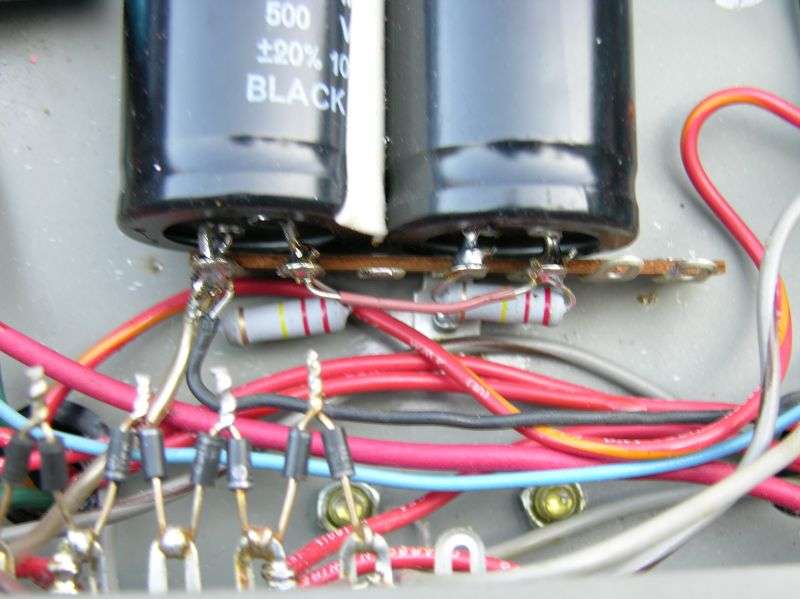Here's a way to simplify replacement of the filter caps in the D&A amplifiers of days gone by.
The original setup for the ten-tube Phantom was two series strings of three caps, each rated 100uf at 350 Volts. This produced the equivalent of a single 33uf cap at 1050 Volts. Since the actual high-side B+ is clower to 900 Volts, this was a reasonable rating.
Nowadays, the axial-lead cap used in the 1970s is expensive. You can buy a so-called "snap-in" type cap meant for pc boards a lot cheaper if you shop around.
One way is to use caps rated for 500 Volts. You only need two of these in series to do the job of the original three parts.
The Maverick used only one string of three caps. The Phantom model used two, for a total of 66uf in the high-side B+.
The Low side was filtered by a pair of these same caps in series. A single 500-Volt part works fine to replace those two.

Here is a Maverick we converted to a straight 6-tuber. The Phantom uses the exact same setup. These caps are overkill for a Maverick, and they still provide nearly twice the total capacitance found in the Phantom for High side.

Feel free to use smaller ones. It's just easier for me to stock the one type cap for both.
Just don't forget the bleeders. Nothing magic about the resistance value, so long as both resistors in the series pair are the same. Most any value from 220K to 390K is alright for a 2-Watt rated part.
Just don't use old carbon-comp resistors. They have a bad habit of changing resistance value with heat and age. Not a good way to divide the voltage equally two ways on the series pair of caps.
Oddly enough the standard 4/10 of an inch spacing of these 'snap-in' radial caps lines up pretty well with the lugs on the original tie strips used to anchor the original caps. The double-side foam we used to stick them down is called 3M "VHB". It won't get brittle and let go. Heat only seems to make it stick better.
Just don't get zinged removing the old filter caps. Discharge EVERY one of them, one at a time. The factory used only single resistor as a bleeder. Didn't work. The old ones may still be hot. Don't discover it by cracking an elbow when your reflexes draw away from the surprise.
73
The original setup for the ten-tube Phantom was two series strings of three caps, each rated 100uf at 350 Volts. This produced the equivalent of a single 33uf cap at 1050 Volts. Since the actual high-side B+ is clower to 900 Volts, this was a reasonable rating.
Nowadays, the axial-lead cap used in the 1970s is expensive. You can buy a so-called "snap-in" type cap meant for pc boards a lot cheaper if you shop around.
One way is to use caps rated for 500 Volts. You only need two of these in series to do the job of the original three parts.
The Maverick used only one string of three caps. The Phantom model used two, for a total of 66uf in the high-side B+.
The Low side was filtered by a pair of these same caps in series. A single 500-Volt part works fine to replace those two.

Here is a Maverick we converted to a straight 6-tuber. The Phantom uses the exact same setup. These caps are overkill for a Maverick, and they still provide nearly twice the total capacitance found in the Phantom for High side.

Feel free to use smaller ones. It's just easier for me to stock the one type cap for both.
Just don't forget the bleeders. Nothing magic about the resistance value, so long as both resistors in the series pair are the same. Most any value from 220K to 390K is alright for a 2-Watt rated part.
Just don't use old carbon-comp resistors. They have a bad habit of changing resistance value with heat and age. Not a good way to divide the voltage equally two ways on the series pair of caps.
Oddly enough the standard 4/10 of an inch spacing of these 'snap-in' radial caps lines up pretty well with the lugs on the original tie strips used to anchor the original caps. The double-side foam we used to stick them down is called 3M "VHB". It won't get brittle and let go. Heat only seems to make it stick better.
Just don't get zinged removing the old filter caps. Discharge EVERY one of them, one at a time. The factory used only single resistor as a bleeder. Didn't work. The old ones may still be hot. Don't discover it by cracking an elbow when your reflexes draw away from the surprise.
73
